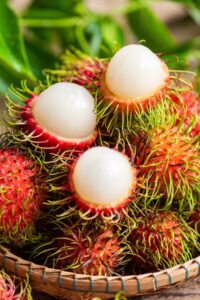What is lychee fruit, you ask?
It’s a yummy, sweet, and juicy treat native to southeastern China and northern Vietnam.
It has a fun, jelly-like consistency many people find off-putting, but others love it.

It features prominently in Asian cuisine but is less popular in the United States.
If you can find it, though, you’ll definitely want to buy it. It’s a wonderful fruit with which to experiment.
Still not sure about it? Don’t worry, I’m about to tell you all the reasons you should try it.
So stick around to learn more about lychee fruit, how it tastes, and more!
What is Lychee Fruit?
(scientific name: Litchi chinensis)
Lychees are small, oval-shaped fruits with red, bumpy skin and translucent, jelly-like flesh.
They look similar to both longans and rambutans but are different from both.
They grow in bunches and are relatively small. (They’re much smaller than standard kiwi fruits.)
They’re typically lightweight and about two inches around.
Each one has a single large pit (seed) in its center. To enjoy them, you peel the skin off and eat the flesh.
Neither the seed nor the skin is edible, only the translucent flesh within.
The fruits are very juicy and delicious. Unfortunately, they can be difficult to find outside of Asia.
Your best bet is a local Asian market.
You may also be able to find them (when in season) on Amazon or exotic fruit websites.

What Does Lychee Taste Like?
Lychee fruits taste and smell incredible. They’re mild, sweet, slightly flowery, and juicy, with just a hint of tart tanginess.
Some people claim they notice citrus notes in the flavor. Others insist they taste more like berries than anything else.
The taste can vary depending on the fruit’s ripeness. However, I think they taste primarily like floral-tinged pears.
As long as you enjoy sweet fruit, you’ll love them.
However, keep in mind that the taste also varies between fresh and canned lychee fruit.
While the canned fruit still tastes good, it’s not as bold or flavorful as its fresh counterparts.
Health Benefits of Lychee Fruit
People have used lychee fruits in Chinese medicine for decades, and with good reason!
Lychee fruits are powerhouses of antioxidants. They’re also more than 80% water, which is great for staying hydrated.
Furthermore, lychee fruits include a ton of vitamins and minerals, such as:
- Vitamin B6: 11% daily value per 190-gram serving
- Fiber: 10% daily value per 190-gram serving
- Vitamin C: 151% daily value per 190-gram serving
- Oligonol
- Copper
- Potassium
Moreover, lychee has been studied for other medicinal properties.
Some evidence suggests that regular consumption of lychee could be incredibly beneficial. Here are the most common ways:
- Aiding in weight loss
- Providing anti-aging assistance
- Boosting the immune system
- Helping with digestion
- Improving circulation
- Regulating blood pressure
- Acting as an anti-inflammatory
With all of that going for it, it’s no wonder the fruit is so sought-after.

Lychee vs. Rambutan
As I’ve already mentioned, lychees and rambutans are a lot alike. However, they’re two totally different fruits.
Let’s look at their similarities first. Then, we’ll explore their differences.
Both fruits come from the Sapindaceae (or soapberry) family. They’re of the same approximate shape and size.
Plus, they’ a’re almost indistinguishable without their skins.
Once you peel them, they both look like small, oval-shaped, translucent eggs.
They’re both on the sweeter side of the flavor spectrum, as well.
As for differences, the two are noticeably distinct with their skins intact.
Lychee fruits are bright pinkish-red, almost the same color as a raspberry.
Rambutans are a darker red, almost more brown than red.
Additionally, rambutans are covered in long non-sharp spikes. On the other hand, lychees’ skins are simply bumpy.
Rambutans can grow larger than lychees, though they don’t always. Also, their taste is fresher and less floral-like.
How to Use Lychee Fruit
Lychee is a great and healthy food to snack on. However, that’s not the only way to enjoy them.
You can chop them up and add them to fruit salads or make smoothies with them.
Because the fruit is so juicy, it also makes an excellent simple syrup. (And lychee cocktails are divine!)
You can juice them, though it would take several for a glass, or turn them into jams and salsas.
Finally, turn them into lychee sorbet or lychee ice cream!
They work really well in desserts, thanks largely to their natural sweetness.
You can find several more lychee recipes online.

How to Store
Besides being hard to find, lychees have another downside.
They ripen quickly and go bad even quicker. Your lychee can easily go from fresh to fermented in almost no time.
Knowing how to store them properly will help.
You can refrigerate or freeze lychees to extend their lives.
However, they taste best when eaten fresh and very soon after purchasing them.
If you must store them, here are your options:
- Wrap them individually in paper towels and place them in Ziploc bags. Store them in the fridge for 5 to 7 days.
- Place them in freezer-safe Ziploc bags and remove as much air as possible. Pop them in the freezer and keep them for 4 to 6 weeks.
You can eat them without allowing them to thaw if you freeze them.
Just peel them and pop them straight into your mouth.










